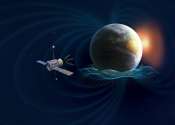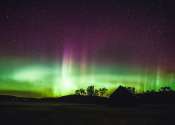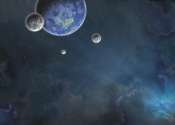First detection of negative ions on the moon
The first ESA instrument to land on the moon has detected the presence of negative ions on the lunar surface produced through interactions with the solar wind.

The first ESA instrument to land on the moon has detected the presence of negative ions on the lunar surface produced through interactions with the solar wind.
Space Exploration
Jun 6, 2024
0
15

New research led by Lia Siegelman, a physical oceanographer at UC San Diego's Scripps Institution of Oceanography, shows that the roiling storms at the planet Jupiter's polar regions are powered by processes known to physicists ...
Planetary Sciences
Jun 6, 2024
0
125

Exoplanets are common in our galaxy, and some even orbit in the so-called habitable zone of their star. NASA's James Webb Space Telescope has been busy observing a few of these small, potentially habitable planets, and astronomers ...
Space Exploration
Jun 5, 2024
0
82

Olivine is the earliest mineral to crystallize from basaltic magma, and accurate knowledge of olivine/melt partition coefficients (DOl-melt ) for first-transition row elements (FTREs) Ga and Ge, is required in quantitative ...
Planetary Sciences
Jun 5, 2024
0
2

A new method of detecting high-frequency gravitational waves (HFGWs) has been proposed by a research team led by Prof. Tao Liu, Associate Professor from the Department of Physics at the Hong Kong University of Science and ...
Astronomy
Jun 5, 2024
0
83

A rare exoplanet that should have been stripped down to bare rock by its nearby host star's intense radiation somehow grew a puffy atmosphere instead—the latest in a string of discoveries forcing scientists to rethink theories ...
Planetary Sciences
Jun 5, 2024
0
31

In May, powerful solar storms delivered stunning auroras to latitudes that rarely experience them. Light shows were seen as far south as Florida and Texas, while more northerly areas of the United States were treated to spectacular ...
Astronomy
Jun 4, 2024
0
28

One underappreciated aspect of the current flood of exoplanet discoveries is the technical marvels that enable it. Scientists and engineers must capture and detect minute signals from stars and planets light years away. With ...
Astronomy
Jun 4, 2024
0
8

As we discover more and more exoplanets—and the current total is in excess of 5,200—we continue to try to learn more about them. Astrobiologists busy themselves analyzing their atmospheres searching for anything that ...
Astrobiology
Jun 4, 2024
0
1

Ever since aurora chasers discovered Steve, a mysterious ribbon of purple light in the night sky, scientists have wondered whether it might have a secret twin. Now, thanks to a photographer's keen eye, and data from ESA's ...
Astronomy
Jun 4, 2024
0
53